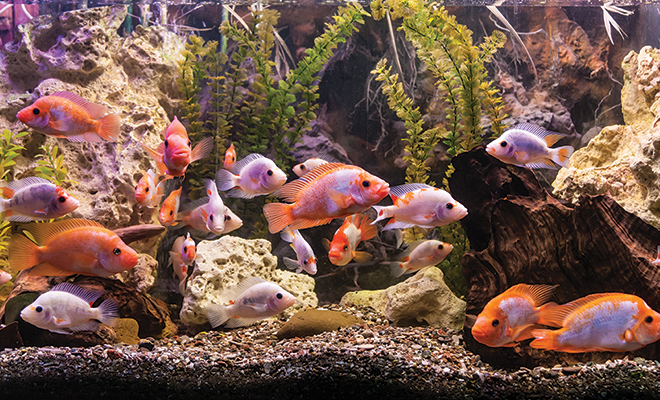
Go Fish
Gurgle, gurgle, gurgle. The sound of bubbling water coming clean as it recirculates through the filter is rhythmic and soothing. The soft glow emanating from inside the glass provides a natural night light, illuminating the room just enough to provide a stumble-free, middle-of-the-night trip to the bathroom. The oranges, yellows and blues swimming through the water create a work of art just as brilliant as any masterpiece hanging on the walls. The rote task of pinching out tiny bits of food every night, realizing these tiny life forms are dependent on that food to maintain life, offers an elementary lesson in responsibility.
The fish tank is often one of the first meanders into the world of pets for many households. Depending on what size you choose, it can fit into even the smallest apartment, yet it serves as an entire world, a created habitat for one of nature’s tiniest pets. And if you don’t care for it properly, your new project can become a pool of murky, deadly water.
While there are about 28,000 different species of fish on the earth, there are basically only two types of environments in which they can survive, freshwater or saltwater. Here is where you make your first decision, after the one you make to purchase aquatic life.
Freshwater aquariums are typically lower maintenance and less expensive than saltwater fish tanks and are recommended for the beginner. They can range from the most simple bowl of water housing a goldfish or betta to an elaborate tank holding hundreds of gallons of water. Equipment needed for an average size freshwater tank includes a water filter, a thermometer, gravel, light, decorations, fish net, test kit, water conditioner and food. Depending on the type of fish you choose, you may also need a heater.
Saltwater aquariums require more maintenance and are more costly to set up, but allow you to house the most colorful, exotic tropical fish and mimic the ocean floor. Additional equipment includes circulation pumps, a refugium, a hydrometer, marine salt and substrate.
The size of the tank is another decision you will need to make. Think about where it will fit, the size of your budget, and the variety and type of fish you are interested in. Larger tanks may cost more initially, but will allow for more flexibility. As a general rule, bigger is better. If you start with a smaller number of fish, you can always add more later. A higher capacity tank will also allow for healthier water and fish as there is more room for the chemicals and waste to circulate. A ten-gallon tank may be cheaper, but a twenty-nine-gallon tank will give you better results and more satisfaction over the long term.
When deciding where to place your aquarium, be sure the surface underneath is level and steady and out of the way to prevent it from being bumped into or knocked over. Do not place it in direct sunlight as too much light could lead to excessive algae buildup. Keep it away from heating vents, windows and doors to avoid too much fluctuation in temperature.
Be careful of overcrowding. A good rule of thumb to follow when stocking your aquarium is an inch of fish for every gallon of water. Be sure to take into consideration their adult size, not how big they are when you first buy them. You will also want to allow more room for the faster-swimming and more aggressive fish.
The type of fish you choose will depend first on the environment, on whether your tank is filled with freshwater or saltwater, and whether it is heated or not. Start with the most hearty and healthy fish and you can add more once they have acclimated. When buying your fish, choose a reputable pet shop. Select only the fish that are alert, are active but not skittish, have clear eyes, have full but not bloated stomachs, have well-shaped fins, are breathing naturally and steadily, and appear clean and colorful and without blemishes or excess slime.
Keep in mind that your fish need a habitat similar to one where they thrive in nature. Buy only the best quality plants and rocks. Live plants are preferable as they control algae, improve water quality, reduce stress for the fish, and give your aquarium a more natural appearance.
Once it’s running, keep your aquarium clean and maintain the equipment on a regular basis. If you go away for more than a few days, arrange for someone to look in on it.
Though they are small, fish are like any other pet in that they need daily attention and love. Always remember–their little lives are in your hands. HLM
Sources: drsfostersmith.com, en.wikipedia.org, pets.thenest.com and successfulreefkeeping.com.







